
We are celebrating 15 years — and counting — of stories that are deeply researched and deeply felt, that build a historical record of what the city has been.
We are celebrating 15 years — and counting — of stories that are deeply researched and deeply felt, that build a historical record of what the city has been.
Last month, we published “Trangressing the Grid: Adventures On (and Off) Manhattan Island” by Philip Kay, the winning entry in our essay competition for original non-fiction writing inspired by the Manhattan street grid “as paradigm, rubric or muse for urban life.” Today, we present “The Grid and its Guises” by Aaron White, one of two runners-up from the competition. While Kay’s essay took a series of personal recollections as the point of departure for his reflections on metropolitan movement and memory, White’s take on the grid invokes canonical urbanist texts and offers a formal analysis of cartographic representation. His range of references serve to buttress an argument that’s less about new ways of interpreting the grid than about what two centuries of its interpretation can tell us about ourselves. –C.S.

Photo by Flickr user EJP Photo
Isn’t the most fascinating thing about the grid really our fascination with it? The grid can be described in a paragraph and understood at a glance, but that has not kept us from spending the 200 years since 1811 accounting and re-accounting for it. A merely objective investigation would have exhausted this subject long ago, suggesting that when we talk about the grid we’re really talking about almost anything but. It seems that the grid is to our time what the Cross was to the Middle Ages, or the sphere to the Renaissance, not just a way of organizing things in the world, but of understanding our relation to that world.
By “The Grid,” we mean many things including but not limited to: the organization of blocks and streets in New York City, the 1811 Commissioners’ Map where these were first laid out, techniques of surveying and partitioning the land, and the political and legal systems required to do so. While these references are in no way equivalent, we nevertheless weave them in and through one another with remarkable results. Beginning with quite mundane realities — a pattern, a map, some laws and a few stakes in the ground — we manage to end up with nothing less than a myth of our own origin.
This well-known genesis story, three commissioners and a map setting the future of Manhattan for all time, is just one of many myths the grid gets pulled into. It’s an interesting one because in it the grid is both subject and object, process and product, but it’s only one of many. The grid seems to possess a promiscuous availability that allows us to hang the most varied discussions upon it. The temptation then is to ask which of these grids is The Grid? As if in a hall of mirrors, we imagine there to be some singular source, knowable in itself. This source, however, is all too easily found, and always less than its reflected image. The grid is in the world but not of the world, and things are attributed to it that can in no way be counted back into its substance.

The Commissioners’ Plan of 1811, John Randel, Jr. | Courtesy of the New York City Municipal Archives
In what follows, I want to present two examples that illustrate this promiscuous availability and its effects. I make no presumption to anything like a definitive conclusion on these matters, nor do I believe a definitive conclusion to be possible. I only wish to show how the grid is always more than the grid because we are always-already putting it to our own ends, and that this may be its most fundamental reality.
Let’s begin by turning to two of our most authoritative urbanists. Lewis Mumford, in his 1961 The City in History, and Rem Koolhaas, in his 1978 Delirious New York: A Retroactive Manifesto for Manhattan, give strikingly different, we could even say violently opposed, accounts of the grid. That a grid, an almost featureless geometry, should generate strong sentiments of any kind is already vexing, but that it should lead two of our most astute urban thinkers to radically divergent assertions seems almost unbelievable. Yet we can track this divergence point by point. For instance, while Koolhaas says that “the grid makes the history of architecture and all previous lessons of urbanism irrelevant,” Mumford says that “the [grid] pattern was an ancient and familiar one.” While Koolhaas informs us that “since…the number of its blocks [are] forever fixed, [the city] cannot grow,” Mumford opposes him saying “being conceived as a purely physical agglomeration…the town planned on these lines could sprawl in any direction.” While Koolhaas lauds the grid’s visionary audacity, Mumford disparages its servile commercialism. And while Koolhaas ends in praising the grid as “the most courageous act of prediction in Western Civilization,” Mumford ends in discarding it as nothing but “paper pretense.”
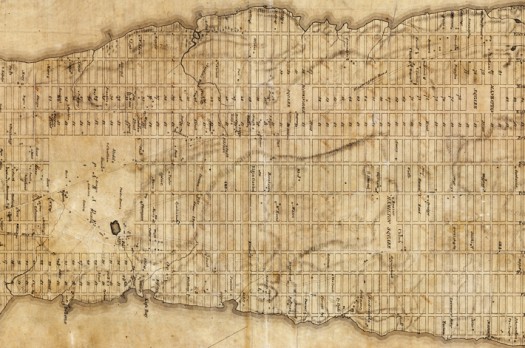
The Commissioners’ Plan of 1811 (detail), John Randel, Jr. | Courtesy of the New York City Municipal Archives
Were the grid simply an object, then it would need to be monstrous indeed to contain such an amalgam of mutually exclusive qualities. But if it’s not just an object, if it is, rather, a means of understanding ourselves and the world and ourselves in the world, then it’s not just Koolhaas and Mumford that tell us something about the grid, but the grid that tells us something about Koolhaas and Mumford.
When Mumford derides the grid, he does so on the grounds that it is a fantasy, and a commercial fantasy at that. But is it possible that he is not opposed to fantasy as such, but only to the limited ambitions of this one? Is it possible that the grid is not fantastic enough for Mumford? We need only look to his own ideal, the so-called “organic city,” which seeks the “interplay of many needs, purposes, and functions,” to see his own fantasy at work. In place of the single-mindedness of the grid, Mumford substitutes a multiply-determined system in which human purpose is only one of many factors to be negotiated. Now, on the face of it, this kind of compromise sounds like the opposite of fantasy, but whereas the grid may be bold enough to destroy God’s works, it’s humble enough to respect His ways. In other words, although the grid may oppose nature, it dares not touch the distinction between the natural and the cultural. The fantasy of the “organic city” is that a cultural artifact, sufficiently related to its milieu, might overcome its very artificiality; and that for our part we, its citizens, might stop privileging ourselves in order to once again participate in the natural interplay. But isn’t the city nothing but an attempt to transcend this interplay? While the grid only seeks to manifest our desires, the organic city seeks to subsume them in that which they thought to transcend. But if this were acceptable, why would we have made the city in the first place?
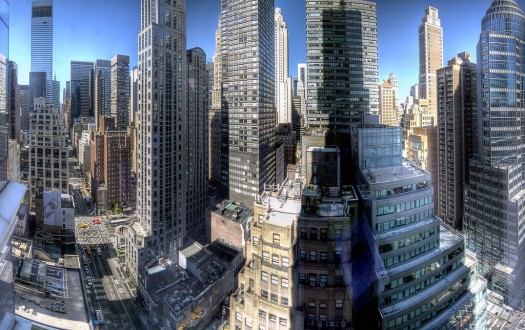
Towers on the Grid | Photo by Brian Hoffsis
And what of Koolhaas? In praising the grid as a courageous prediction, is it possible that he also sees the opposite? In reading the Commissioners’ report (which Koolhaas does at length) one is at great pains to detect anything like courage. Rather, a feeling of claustrophobic necessity permeates the text. It seems that the grid will be because it must be, leaving the Commissioners very little choice in the matter. It’s possible, as Koolhaas argues, that what we have here is a difference between actual and stated intentions, but how courageous is an intention that can’t be stated? And isn’t this tension, although disavowed, already latent in Koolhaas’ analysis? While he explicitly calls the grid a courageous prediction, the form of his analysis, the very retroactive-ness of the manifesto, presumes that the Commissioners are unable to discern their own motives, and are therefore in need of his interpretation. Perhaps this is the case, perhaps all our motivations can only be discerned ex post-facto, but if it is the case, would courage, prediction, and planning even be possible?
The grid tells us about Mumford and Koolhaas because it allows, even demands, that we weave ourselves into its story. Mumford is correct, the grid is too amenable to speculation for good taste and good sense, but then again, don’t we enjoy speculation a little more than we should? And Koolhaas is correct, the grid is too maniacal to be the outcome of practical expediency, but if we are the masters of any art, it’s the art of subsuming desire in necessity so as to make necessity desirable.
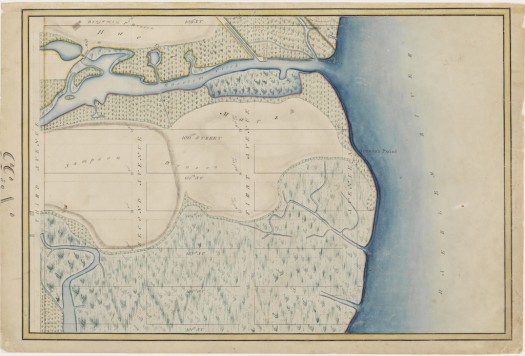
Randel Farm Map no. 55, vol. 1, p. 16, showing 101st to 109th Street, from Third Avenue to the East River, July 21, 1820 | Used with permission of the City of New York and the Office of the Manhattan Borough President
The grid tells us something about ourselves, but it also mediates our relation to the world and therefore allows us to see that world in new ways. One of the clearest examples of this is not surprisingly in the work of the map-maker himself, John Randel Jr.
John Randel Jr. was hired by Simeon DeWitt, one of the three 1811 commissioners, to conduct a survey of Manhattan and draft the official 1811 map. Now maybe I’ve been looking at this map for too long, but while I find it to be an entirely serviceable document, it lacks all the artistic flair and informational nuance we might expect from a map of such consequence. In it, existing roads are not distinguished from proposed roads, built blocks not distinguished from unbuilt, the topographic information provided is of the vaguest kind, and everything is rendered in a single grey. The 1811 map however was not the end of Randel’s map making. Immediately after finishing the 1811 map, Randel started on another set of maps known as his “Farm Maps.” Here, the landscape erupts in a lively complexity. We see intricate topography, ecosystems, water suddenly a deep blue, and property lines taking myriad hues to represent their various owners. Even the map’s scale has been increased dramatically to show this unexpected surplus of information. So what gives? We might say that freed from the grid, Randel is now able to attend to the landscape — except the grid is still there, and there in a most interesting manner. To my eye at least, whereas the 1811 map treats the grid as an underlay, the Farm Maps treat it as a pattern embossed into the landscape itself. Is it possible then that the full color and complexity of the pre-grid world was only legible to Randel once the grid was in place? That ironically it was the “commercial fantasy” that allowed Randel to see “the interplay of many functions”? That the grid, as an ever present threat, fated to undo the seemingly timeless landscape, gave this landscape an intensity it had lacked, an intensity that was at the same time a preemptive nostalgia?
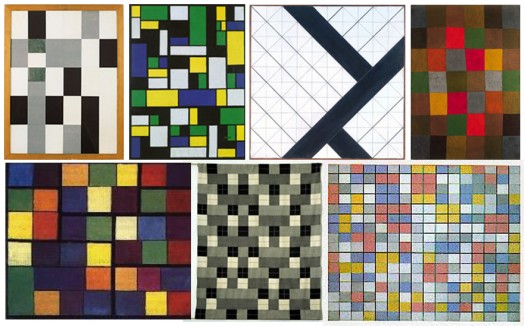
Clockwise from top left: Jean Arp and Sophie Taeuber: Duo-Collage, 1918; Vilmos Huszat: Composite, 1918; Theo van Doesburg: Counter-Composition VI, 1925; Paul Klee: New Harmony, 1936; Piet Mondriaan: Compositie ‘dambord’ met lichte kleuren; Anni Albers: Wanderhang, 1927; George Vantongerloo: Etude, 1918
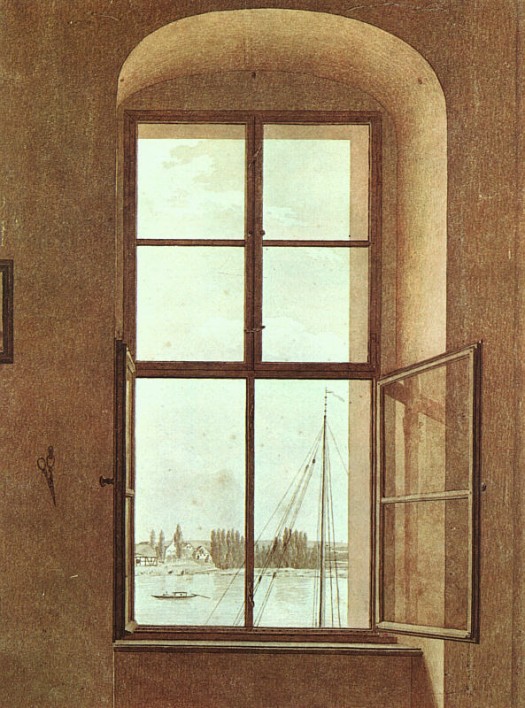
View from the Artist’s Studio By Caspar David Friedrich, 1805 – 06, one of the symbolist paintings to which Krauss refers in her seminal essay, “Grids.”
The other way to read the grid in these maps is as a window casting its shadow on the landscape. In the essay “Grids,” Rosalind Krauss reads another grid-as-window in the symbolist art of the 19th century. Her analysis hinges on the window’s simultaneous transparency and opacity. She states, “As a transparent vehicle, the window is that which admits light — or spirit — into the initial darkness of the room. But if glass transmits, it also reflects. And so the window is experienced by the symbolist as a mirror as well — something that freezes and locks the self into the space of its own reduplicated being.” The grid is our reduplicated image, embossed into the landscape and reflected back to ourselves. The grid-as-window may give access to the world, but this access is mediated. Therefore, in apprehending the world we are thrown into it, projected onto the landscape, which is of course nothing but our own reflection.
I’m interested in what we’re saying about ourselves when we commemorate the grid. Are we asserting our predictive powers? Our control? Are we retroactively manifesting a fantasy of ourselves? Why 1811? Why not, say, the much older Castello Plan of 1660, or the Mangin-Goerck Plan of 1803, where a gridding of Manhattan is already proposed? The truth is that the history of aborted plans is a scandal for “The Plan.” But in the end, the idea that the grid is a plan at all might just be another part of its myth, a part that allows us to leave it “unfinished,” and thereby hold out the possibility of more to come.
.
This essay is a runner-up of an essay competition held in connection with a pair of exhibitions presented by the Museum of the City of New York and the Architectural League of New York that commemorate the Manhattan grid and explore its evolving legacy. The exhibitsʼ premise is that the grid has been subject to countless adaptations and transformations over the past 200 years and will be subject to more urban innovation in the years to come. The Greatest Grid: The Master Plan of Manhattan, 1811-2011, curated by Hilary Ballon, explores the 200 years since the creation of that foundational plan through the lens of the gridʼs enduring impact on land use, real estate and the public realm. The Unfinished Grid: Design Speculations for Manhattan, curated by Gregory Wessner, displays eight design proposals – selected from a pool of over 120 submissions from around the world – that project ways “to act on and within the grid to respond to the challenges and opportunities… that New York faces now and into the future.” Both exhibitions are on view at the Museum of the City of New York through July 15th, 2012.
The views expressed here are those of the authors only and do not reflect the position of The Architectural League of New York.